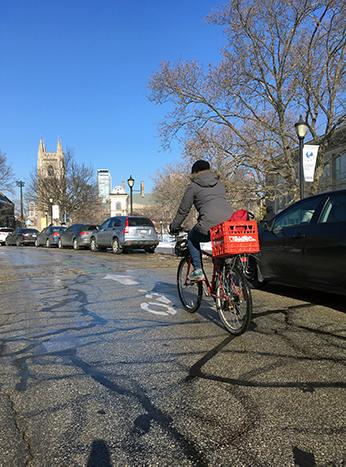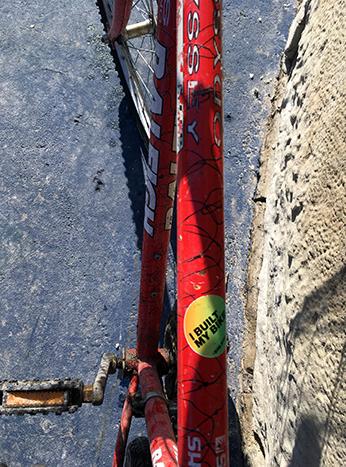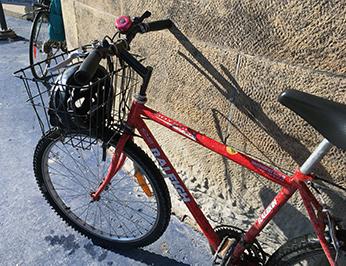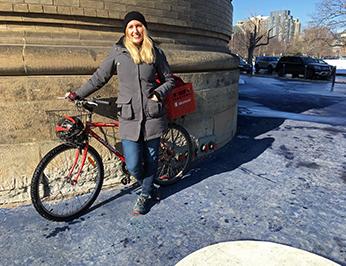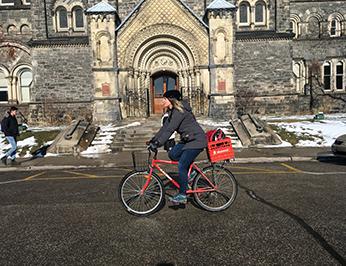
#bikewinterview: Léa and her hardy winter bike

Léa is a busy PhD student at the University of Toronto who works alongside Bike Host, Toronto's cycling mentorship program for newcomers, for her research on gender and cycling. Having grown up just outside of Montréal, Léa knows a thing or two about deep winter. Read on to find out how she built up a sturdy winter bike, three key winter riding accessories, and what she wishes the City would do expand our winter cycling network.
Tell us about your typical commute.
My bike is my primary mode of transport all year long (though I use the TTC a lot more in the winter). I bike to my office at UofT a few times a week. In the winter, it takes me less than 20 minutes by bike and - wait for it - 30-45 minutes by streetcar!
Why do you ride in the winter?
Honestly, it’s still the fastest, most convenient, and most reliable way to get around the city. It’s also a lot warmer than walking...unless it’s super windy. On those super cold and windy days, I add wool socks, leg warmers, and a balaclava to my normal winter gear. Also, if I need to go somewhere far, I hop on the TTC!
How does your riding change in the winter?
Most winter days my route doesn’t change because the roads are clear and easy to ride on. Sadly, I do need to avoid many of my go-to routes, like quiet residential streets, contraflow lanes, etc., on snowy days because they are not ploughed properly. Luckily for me, super snowy days are relatively rare in Toronto! I can also always find an alternative on busier, and generally better-maintained roads*.
I also ride a bit more slowly in the winter - partly because my winter bike is heavy, partly because of the cold, and partly because I feel I need to be more cautious around drivers who seem less aware of cyclists in the winter.
*Note: the City of Toronto’s PlowTO map shows which streets are being plowed and salted in real-time - a useful tool for route planning after a snowfall.
What’s one tip you’d share with someone new to winter biking?
Just give it a try – I bet you’ll be surprised at how convenient and warm it is!
For me, winter biking was something I got into gradually. I started out riding my road bike on warm and clear winter days. Before long, I was testing out how my bike could handle snowier rides.
I really love my summer bike and didn’t want put it through the salty winter roads, so last year I built myself a winter bike at Bike Pirates (one of Toronto’s excellent DIY bike shops). My good friend wanted to build one and convinced me to join her. I had next to no mechanical skills when I started this project (I could fix a flat, but not much else!), so I was pretty nervous.
The Bike Pirates volunteers impressed me as they patiently walked me through every step. It ended up being a social, rewarding, and empowering project. It took me about eight two-to-four- hour sessions at the shop to finish my bike. They charge you a $50 flat fee + whatever new parts you add to the bike (e.g. brake cables - you don’t want those second hand!). My entire bike cost less than $100, plus a donation to this great organization. They even let you keep the bike in the shop for the duration of the project, so you don’t have to worry about dragging it home and back every time. Overall, it was a great experience: I learnt a lot about bike mechanics and now have a sturdy bike that can handle salt and snow.
Top winter riding accessory or bike part?
When you first start off, be sure to have warm gloves or mittens: cycling may be warmer than walking, but your fingers can get cold! A second helpful accessory is front and rear fenders - it is a lot wetter out there in winter than summer! Once you’re ready to face the very cold days (below -20°C), I’d suggest getting a small bottle of de-icer (about $3), leggings, and a balaclava.
Best spot to warm up after a chilly ride?
Believe it or not, I often need to cool down after a winter ride. My chilly Dundas West apartment or my U of T office are fine spots to do that.
What’s one myth you’d like to dispel about winter biking?
You do not have to be hard-core to bike in the winter. It really isn’t as hard as it looks!
--
Interested in building up your own winter bike, like Léa did? Check out these DIY spaces in Toronto.
- Bikesauce: 341 Broadview Ave.
- Bikechain: 563 Spadina Cres.
- Bike Pirates: 1416 Queen St. W.
- Bike Works at Evergreen Brick Works
Stay tuned for our next #bikewinterview, coming on Winter Bike to Work Day (Friday, February 9)!

